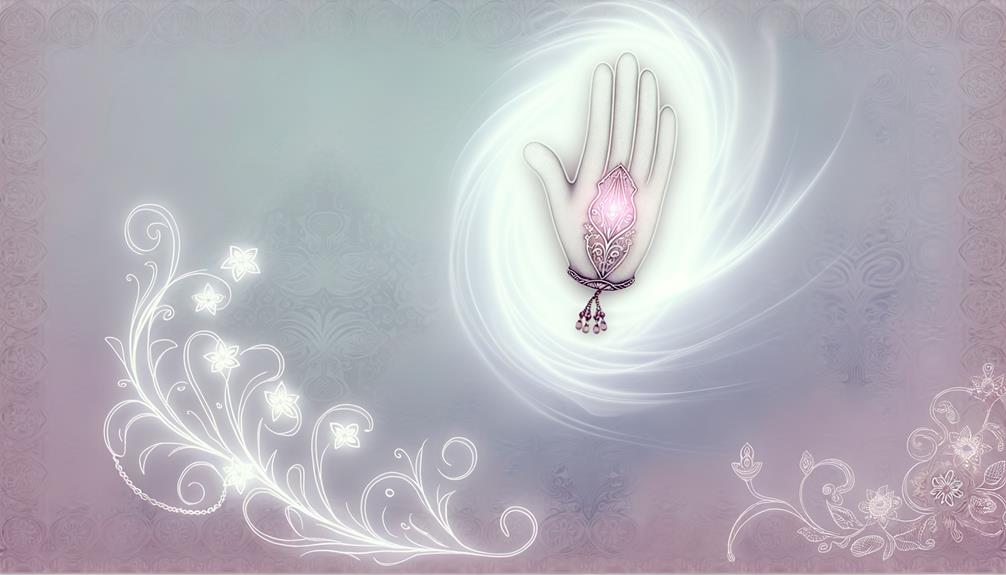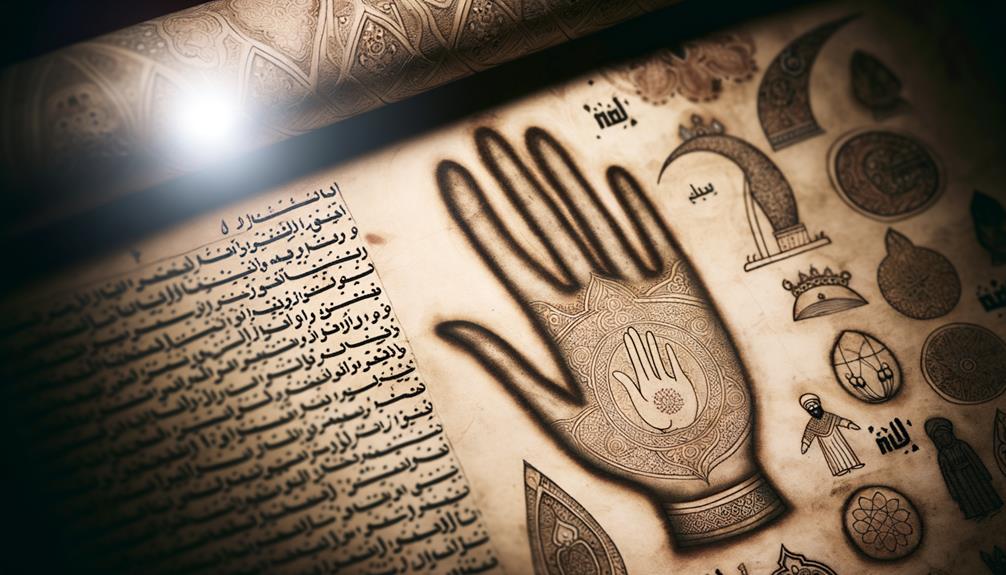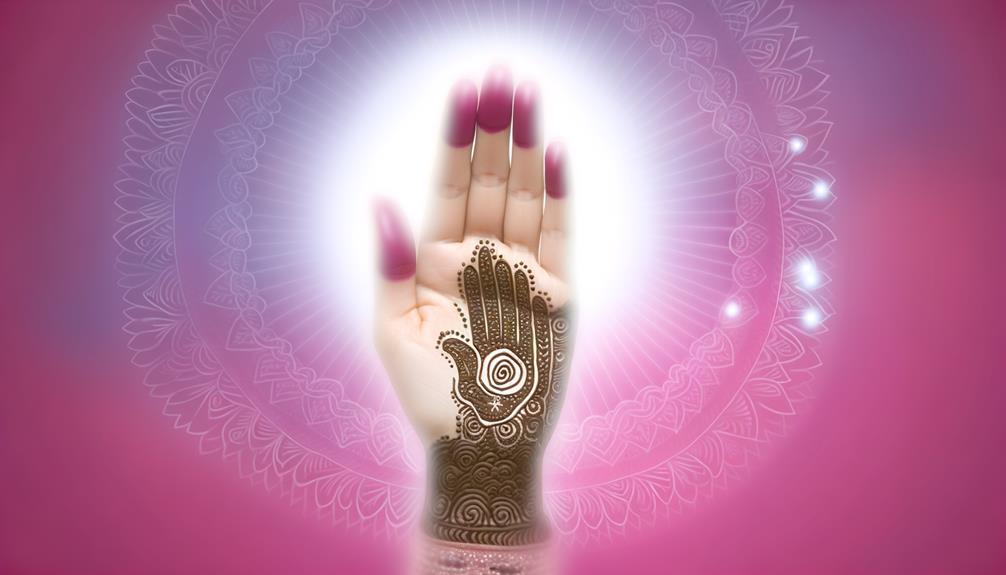Hand of Fatima Spiritual Meaning: Protection and Power
The Hand of Fatima, or Hamsa, is a historical symbol with rich spiritual meaning across various cultures, primarily in Islamic and Jewish traditions. In Islam, it represents divine protection and the Five Pillars, named after Fatima, daughter of Prophet Muhammad, symbolizing family unity.
In Judaism, known as Hamsa, it signifies vigilance against the evil eye and divine intervention, linked to the five books of the Torah. This open-hand symbol is commonly used as a talisman for warding off negative energies and bringing good luck.
Its enduring presence continues to appeal globally, blending deep historical roots with modern spiritual practices. Explore further to uncover its profound cultural significance.

Spiritual Meaning of the Hand of Fatima: Symbolism and Protective Power
| Symbolic Meaning | Spiritual Insight |
|---|---|
| Protection From Evil | Acts as a powerful talisman against the evil eye and negative energies |
| Divine Feminine Energy | Represents compassion, strength, and nurturing from sacred feminine forces |
| Faith and Patience | Symbolizes deep spiritual endurance and trust in divine timing |
| Unity and Peace | Promotes harmony, balance, and interconnectedness |
| Spiritual Guidance | Believed to bring blessings and direction from higher spiritual realms |
Origin and History

Tracing its roots back to ancient civilizations, the Hand of Fatima, also known as the Hamsa, has a rich and multifaceted history that spans several cultures and religions.
Originating in Mesopotamia, it was adopted by various cultures, including Phoenician, Carthaginian, and ancient Egyptian societies. The symbol is often depicted as an open hand with an eye in the center, purportedly offering protection against evil forces.
The Hamsa’s evolution continued through the Jewish and Christian traditions, where it acquired different interpretations and functions. While its exact origins are debated, its enduring presence across millennia underscores its significance.
This cross-cultural symbol has been revered not only for its protective qualities but also as a representation of blessings, power, and strength.
Symbolism in Islam
In Islamic tradition, the Hand of Fatima, or Khamsa, is mainly regarded as a potent symbol of protection and divine providence. This emblematic hand is believed to guard against the evil eye and bestow blessings.
The Khamsa is intricately linked to several key symbolic elements within Islam:
- Five Fingers: Representing the Five Pillars of Islam, which are foundational acts of worship and obedience.
- Protection: Serving as a talisman against negative energies and malevolent forces.
- Divine Guidance: Embodying the spiritual guidance and support from Allah.
- Family Ties: Often associated with Fatima, the daughter of the Prophet Muhammad, symbolizing familial strength and unity.
Thus, the Hand of Fatima is woven deeply into Islamic cultural and spiritual contexts.
Symbolism in Judaism

The Hand of Fatima, known as the Hamsa in Jewish tradition, serves as a powerful symbol of protection and divine intervention within Judaism.
Historically, the Hamsa dates back to ancient Mesopotamia and has been integrated into Jewish culture over centuries. It is often depicted with an eye in the palm, symbolizing vigilance against the ‘evil eye‘ and malevolent forces.
In Jewish mysticism, known as Kabbalah, the Hamsa is associated with the five books of the Torah and the hand of God. Its usage spans decorative arts, amulets, and jewelry, reflecting its deep-seated spiritual significance.
The Hamsa’s enduring presence highlights its role as a universal emblem of faith, transcending cultural and religious boundaries.
Protective Qualities
The Hand of Fatima is widely regarded for its protective qualities, functioning as a powerful talisman to ward off evil and negative energies.
In various cultural contexts, it is believed to bring good luck and foster spiritual strength, contributing to overall well-being.
These protective attributes underscore its enduring significance across different spiritual and cultural traditions.
Ward Off Evil
Considered a powerful talisman, the Hand of Fatima is believed to offer protection against negative energies and malevolent forces. This ancient symbol, deeply rooted in various cultural and religious traditions, is often invoked for its reputed defensive capabilities.
The protective qualities of the Hand of Fatima can be understood through the following aspects:
- Symbolic Representation: The open hand is thought to deflect the ‘evil eye’ and other harmful intentions.
- Cultural Significance: Across different cultures, it serves as a universal symbol of protection and safety.
- Historical Usage: Historically worn or displayed to safeguard homes and individuals from harm.
- Spiritual Belief: Many believe it channels divine protection, creating a spiritual barrier against negativity.
These elements collectively underscore its role as a guardian symbol.
Bring Good Luck
Beyond its protective qualities, the Hand of Fatima is also revered for its ability to attract good luck and positive energy into the lives of its bearers. This amulet, often depicted with an open hand and an eye, symbolizes divine protection and abundance.
Historically, cultures across the Middle East and North Africa have embraced it as a talisman that fosters prosperity and shields against misfortune. The presence of the Hand of Fatima in personal spaces or worn as jewelry is believed to invite favorable outcomes and fortuitous events.
This belief is deeply rooted in the amulet’s association with spiritual blessings and its enduring symbolism of hope and optimism.
Consequently, it serves as a multifaceted emblem of well-being and fortune.
Enhance Spiritual Strength
As a symbol of resilience and divine protection, the Hand of Fatima is believed to bolster spiritual strength and safeguard against negative influences. Its protective qualities are deeply rooted in various cultural and religious contexts, providing a multifaceted approach to spiritual fortification.
Key protective qualities include:
- Ward Off Evil: Traditionally, the Hand of Fatima is seen as a potent amulet that repels the evil eye and harmful intentions.
- Promote Inner Peace: It is believed to enhance emotional stability and tranquility.
- Foster Resilience: Wearing or displaying the symbol is thought to instill courage and perseverance in the face of adversity.
- Encourage Positive Energy: The Hand of Fatima is said to attract beneficial energies, fostering a harmonious environment.
These attributes collectively fortify one’s spiritual well-being.
Feminine Power

The Hand of Fatima, often regarded as a potent symbol of protection, also embodies the essence of divine feminine energy.
This ancient talisman not only safeguards against negative influences but also represents the strength and resilience inherent in the feminine spirit.
Symbol of Protection
Rooted in ancient traditions, the Hand of Fatima, also known as Hamsa, is revered as a potent symbol of protection and feminine power across various cultures. This emblem serves to safeguard individuals from negative influences and malevolent forces. Its widespread acceptance and integration into cultural practices underscore its enduring significance.
The Hand of Fatima’s symbolism can be understood through several key aspects:
- Protection Against Evil: Believed to ward off the ‘evil eye’ and other harmful energies.
- Cultural Unity: Found in Middle Eastern, North African, and Mediterranean societies, signifying a shared heritage.
- Feminine Power: Represents the nurturing and protective qualities of feminine divinity.
- Spiritual Shield: Used in amulets and jewelry to provide a sense of security and well-being.
This multifaceted symbol continues to resonate deeply within contemporary spiritual practices.
Divine Feminine Energy
Recognizing the Hand of Fatima as a symbol of protection naturally leads to an exploration of its embodiment of divine feminine energy, manifested through its association with nurturing and safeguarding qualities.
This ancient symbol, often depicted as an open palm, embodies the essence of compassion, empathy, and the protective instincts traditionally attributed to feminine power.
Historically, the Hand of Fatima has been revered in various cultures for its ability to ward off negative energies, while simultaneously nurturing positive growth.
Its design also incorporates elements that symbolize fertility and healing, further reinforcing its connection to the divine feminine.
Consequently, the Hand of Fatima serves not only as a protective emblem but as a profound representation of the nurturing and resilient aspects of feminine energy.
Embracing Inner Strength
Embracing inner strength through the lens of feminine power involves acknowledging the inherent resilience and fortitude that have historically been undervalued yet are essential for holistic well-being.
The Hand of Fatima, as a spiritual symbol, encapsulates this feminine power by reflecting the following attributes:
- Intuition: Valuing the deep, often underappreciated sense of knowing that guides decisions and actions.
- Compassion: Integrating empathy and care as foundational elements for nurturing relationships and communities.
- Patience: Recognizing the strength in endurance and the capacity to withstand challenges over time.
- Adaptability: Embracing flexibility and the ability to navigate and evolve through life’s myriad changes.
These qualities collectively underscore the profound depth of feminine power, offering a balanced approach to personal and societal growth.
Eye of Fatima
The Eye of Fatima, often symbolized within the Hamsa hand, holds significant spiritual and cultural connotations across various traditions. This emblem is frequently associated with protection, warding off the ‘evil eye,’ and ensuring safety.
The depiction typically features an open hand with an embedded eye, aiming to deflect negative energies. This duality of symbols, the hand and the eye, creates a powerful talisman revered in multiple cultures.
| Symbol | Cultural Context | Spiritual Significance |
|---|---|---|
| Hamsa Hand | Middle Eastern | Protection |
| Eye of Fatima | Islamic and Jewish | Warding off evil |
| Open Hand | Universal | Safety and blessings |
| Embedded Eye | Various (e.g., Mediterranean) | Deflecting negativity |
| Talisman | Cross-cultural | Spiritual safeguard |
This combination underscores the universal desire for security and divine favor.
Modern Interpretations

In contemporary times, the Hand of Fatima continues to hold significant spiritual meaning, evolving to encompass new interpretations while maintaining its traditional protective qualities. This ancient symbol, also known as Hamsa, is now associated with various modern spiritual and cultural themes.
Key modern interpretations include:
- Empowerment: Seen as a symbol of female strength and resilience.
- Unity: Embraced by diverse cultures as a sign of inclusivity and harmony.
- Mindfulness: Adopted in wellness practices for its calming and centering properties.
- Good Fortune: Believed to attract prosperity and positive energy.
These interpretations reflect a blend of historical reverence and contemporary relevance, underscoring the Hand of Fatima’s enduring influence in modern spiritual practices.
Cultural Significance
Widely revered across different societies, the Hand of Fatima holds profound cultural significance that transcends religious and geographical boundaries. In Islamic cultures, it symbolizes protection and is often referred to as the Hand of Fatima, named after the Prophet Muhammad’s daughter. Conversely, in Jewish traditions, it is known as the Hamsa and represents divine protection and blessings. The table below highlights these cultural interpretations:
| Culture | Meaning |
|---|---|
| Islamic | Protection, named after Fatima |
| Jewish | Divine protection, blessings |
| Middle Eastern | Symbol of strength and power |
| North African | Ward off evil, bring good luck |
This cross-cultural appeal underscores the Hand of Fatima’s universal resonance, reflecting shared human values of protection and well-being.
Variations and Designs

The Hand of Fatima, also known as the Hamsa, manifests in various traditional patterns, each rich with cultural symbolism.
Modern design interpretations have expanded its aesthetic and significance, blending contemporary artistry with historical roots.
These variations highlight the adaptability of the Hamsa across different cultures and time periods, reflecting diverse spiritual meanings and artistic expressions.
Traditional Hamsa Patterns
Traditional Hamsa patterns exhibit a rich diversity of variations and designs, each carrying unique cultural and spiritual significance. These patterns can be analyzed based on their intricate details, which serve to enhance their protective qualities and convey deeper meanings.
Notable traditional designs include:
- Five-Fingered Hand: Symbolizing protection, this design often features an eye in the palm, believed to ward off evil.
- Fish Motif: Common in Middle Eastern Hamsas, it represents abundance and good fortune.
- Floral Patterns: These intricate designs are thought to invoke growth, fertility, and harmony.
- Hebrew or Arabic Inscriptions: Religious texts or blessings are often inscribed, adding layers of sacred significance.
Each pattern variation is an embodiment of regional beliefs and artistic traditions, reflecting the Hamsa’s multifaceted role in different cultures.
Modern Design Interpretations
In contemporary contexts, modern interpretations of the Hamsa hand have evolved to encompass a broad spectrum of aesthetic styles and symbolic meanings, reflecting both individual creativity and global cultural exchanges.
Designers now incorporate diverse materials such as metals, ceramics, and textiles, allowing for innovative and personalized renditions. Geometric patterns, minimalist lines, and even abstract forms are prevalent, each iteration imbuing the symbol with unique narratives.
The Hamsa’s adaptability to different artistic movements, from bohemian to avant-garde, underscores its enduring relevance. Additionally, technological advancements in design software have enabled intricate detailing and mass customization, broadening its appeal.
This dynamic evolution signifies how traditional symbols can be reimagined to resonate with contemporary sensibilities and multicultural perspectives.
Cultural Symbolism Variations
Across various cultures, the Hamsa hand manifests in distinct designs and symbolisms that reflect the unique spiritual and historical narratives of each tradition. These variations underscore the symbol’s adaptability and relevance across different societies.
- Middle Eastern Design: Often incorporates intricate floral patterns and Arabic calligraphy, emphasizing protection and blessings.
- Jewish Design: Known as the Hand of Miriam, frequently features the Star of David and the Hebrew word ‘Shalom,’ symbolizing peace.
- North African Design: Typically adorned with fish symbols, representing luck and prosperity.
- Indian Design: Encompasses detailed henna designs, reflecting themes of matrimony and fertility.
Each design variation enriches the Hamsa’s universal appeal, allowing it to resonate with diverse cultural contexts and spiritual meanings.
Usage in Jewelry
The incorporation of the Hand of Fatima into jewelry serves both as an aesthetic adornment and a talisman believed to provide protection and good fortune. This symbol, often crafted into necklaces, bracelets, and rings, transcends mere fashion by embodying centuries-old spiritual connotations.
The Hand of Fatima, or Hamsa, is mainly used in Middle Eastern and North African cultures, symbolizing divine protection. Modern jewelry designers integrate this motif to appeal to a global audience, blending traditional significance with contemporary styles. Below is a table highlighting common uses in jewelry:
| Jewelry Type | Material | Cultural Significance |
|---|---|---|
| Necklace | Gold, Silver | Protection, Good Fortune |
| Bracelet | Beads, Metal | Ward off Evil Eye |
| Ring | Gemstones, Metals | Symbol of Strength and Faith |
This duality in usage underscores its enduring appeal.
Spiritual Practices

Although the Hand of Fatima is widely recognized as a protective emblem in jewelry, its spiritual significance extends into various religious and cultural practices. Historically, the symbol has been employed in diverse rituals aimed at invoking protection, blessing, and healing. These practices are multidimensional, reflecting the rich tapestry of beliefs surrounding the Hand of Fatima.
Key spiritual practices include:
- Meditation: Used as a focal point to enhance concentration and spiritual awareness.
- Rituals: Incorporated in ceremonies to ward off evil and attract positive energies.
- Prayer: Employed as a talisman during prayers for protection and guidance.
- Healing: Utilized in holistic healing practices to promote physical and emotional well-being.
These spiritual applications underscore the Hand of Fatima’s profound cultural resonance.
Conclusion
The Hand of Fatima, with its rich historical roots and multifaceted symbolism, serves as a profound emblem across various cultures and religions.
What makes this symbol so enduring and universally revered? Its associations with protection, feminine power, and spiritual significance render it a potent talisman.
Whether manifested in jewelry or spiritual practices, the Hand of Fatima continues to captivate and inspire, bridging cultural divides and transcending temporal boundaries.






